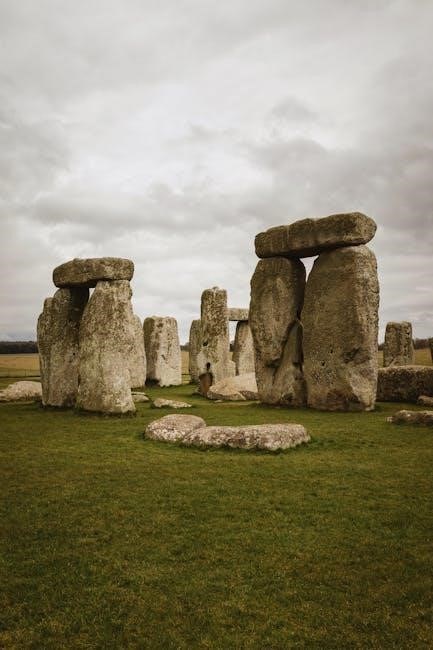
1․1 Overview of Restoration Druid Role
Restoration Druids are hybrid healers specializing in healing over time (HoT) spells, making them versatile in both single-target and AoE healing scenarios․ They rely on spells like Rejuvenation, Wild Growth, and Lifebloom to sustain raid or dungeon groups․ Their ability to shape-shift into various forms enhances mobility and utility, while talents like Tree of Life Form improve healing efficiency․ They excel at proactive healing, reducing incoming damage through HoTs․ Additionally, Restoration Druids bring unique utility, such as magic dispels and instant cast spells, making them a valuable asset to any group composition․
1․2 Importance of Restoration Druid in Raids and Dungeons
Restoration Druids are indispensable in both raids and dungeons due to their flexibility and potent healing toolkit․ Their ability to heal multiple targets simultaneously with AoE spells like Wild Growth and their strong single-target healing with spells such as Lifebloom make them versatile․ They also provide essential utility, including magic dispels and instant casts, which are crucial for handling specific encounters․ Their mobility and shape-shifting abilities allow them to adapt to dynamic combat situations, ensuring consistent healing output even during movement-heavy fights․ This makes them a core healer in many group compositions, capable of handling a wide range of challenges effectively․
1․3 Key Strengths and Weaknesses
Restoration Druids excel with their exceptional mobility, instant-cast spells, and strong AoE healing through Wild Growth․ Their ability to adapt via shape-shifting enhances versatility in dynamic encounters․ However, they can struggle with overhealing, wasting mana on unnecessary HoTs․ While their magic dispel is valuable, it requires a specific talent investment․ In single-target healing, they may lack the raw output of other classes․ Despite these challenges, their flexibility and unique toolkit make them a powerful choice for handling diverse healing demands in both raids and dungeons․

Stats and Gearing for Restoration Druid
Intellect and Spirit are crucial for mana pool and regeneration, while Haste reduces spell cast times․ Gemming with Emeralds and enchanting gear optimizes healing output․ Professions like Tailoring or jc can provide additional benefits, enhancing overall performance in raids and dungeons․
2․1 Primary and Secondary Stats

Intellect is the primary stat for Restoration Druids, increasing mana pool and spell power․ Spirit enhances mana regeneration, ensuring sustained healing․ Haste reduces spell cast times, improving throughput, while Mastery boosts HoT effects․ Critical Strike and Spell Power are secondary, offering inconsistent but beneficial gains․ Balance between Haste and Spirit depends on gear level and raid composition․ Proper stat allocation ensures efficient mana management and optimal healing output, making it crucial for success in both dungeons and raids․
2․2 Haste and Spell Haste Requirements
Haste is a critical stat for Restoration Druids, reducing spell cast times and increasing healing throughput․ The soft cap for spell haste is 12․5%, which lowers cast times to 1 second․ As a Goblin, you need 1858 Haste Rating to reach this cap․ Without a 5% spell haste raid buff, an additional 740 Haste Rating is required․ Prioritizing haste enhances the frequency of HoTs and reactiveness in dynamic encounters․ Balancing haste with other stats ensures optimal performance, making it a cornerstone of Restoration Druid gearing in Cataclysm․
2․3 Gemming Strategy for Restoration Druid
Gemming for a Restoration Druid focuses on maximizing healing efficiency through stats like intellect and haste․ Use Purple Gems (Intellect/Haste) in blue sockets and Yellow Gems (Intellect) in yellow sockets․ Red Gems (Haste) are ideal for red sockets․ Socket bonuses should be considered to enhance overall stats․ Avoid overcapting on haste; instead, balance with spirit for mana regeneration․ This approach ensures sustained healing output and mana efficiency, particularly in prolonged encounters․ Proper gemming is vital for optimizing your druid’s performance in both raids and dungeons․
2․4 Enchants for Restoration Druid
Optimizing enchants for a Restoration Druid enhances healing output and mana efficiency․ Prioritize intellect and haste enchants to improve spell power and casting speed․ Use Arcanum of Hyjal on the head for intellect and haste․ Enchant shoulders with Greater Inscription of the Cowl for intellect and stamina․ Enchant Cloak ‒ Greater Intellect boosts mana pool․ For chests, Enchant Chest ⎻ Exceptional Spirit aids mana regeneration․ Gloves benefit from Enchant Gloves ‒ Haste, and legs from Earthenforge Kilt for stamina and haste․ Feet should have Enchant Boots ‒ Tuskarr’s Vitality for stamina and speed․ Weapon enchants like Heartsong provide haste and spell power․ These enchants ensure balanced healing and sustainability in raids and dungeons․
2․5 Professions for Restoration Druid
Professions play a crucial role in enhancing a Restoration Druid’s effectiveness․ Tailoring is ideal for crafting gear with haste bonuses, while Leatherworking provides bracer enchants for stamina and dodge․ Blacksmithing unlocks extra gem sockets, boosting intellect and haste․ Jewelcrafting offers powerful gem bonuses, increasing spell power․ Alchemy is beneficial for creating flasks and potions to enhance mana regeneration and healing output․ These professions complement gearing strategies, ensuring optimal performance in raids and dungeons․ Choosing the right profession can significantly improve healing capabilities and mana sustainability during intense encounters․

Talents and Builds
Restoration Druid talents in Cataclysm focus on enhancing healing efficiency and mana conservation․ Key talents improve spell cast times and intellect, ensuring optimal performance in various roles․
3․1 Core Talents for Restoration Druid
Core talents for Restoration Druids in Cataclysm focus on mana efficiency and spell effectiveness․ Natural Shapeshifter reduces mana costs for shapeshifting, while Naturalist decreases Healing Touch and Nourish cast times․ Heart of the Wild boosts intellect, enhancing overall healing output․ These talents are essential for maintaining high throughput and mana sustainability, making them indispensable for any Restoration Druid build․ They ensure the druid can consistently deliver heals while managing mana effectively, especially in prolonged fights․
3․2 Optional Talents and Their Uses
Optional talents for Restoration Druids in Cataclysm offer flexibility based on playstyle and encounter needs․ Nourish provides a fast, mana-efficient direct heal, ideal for situations requiring quick, targeted healing․ Empowered Touch enhances Healing Touch, reducing its cast time and increasing crit chance, beneficial for heavy tank healing․ Living Seed triggers a hot on targets healed by Swiftmend, adding passive healing․ These talents allow druids to adapt to specific roles, such as tank healing or burst damage scenarios, without compromising their core healing capabilities․ They enhance situational effectiveness but aren’t mandatory for every build․
3․3 Talent Builds for Different Playstyles

Glyphs for Restoration Druid
Glyphs enhance Restoration Druid’s abilities, offering utility and situational benefits․ Major glyphs like Glyph of Rebirth and Glyph of Healing Touch provide strategic advantages, while minor glyphs offer convenience, ensuring optimal performance in various encounters․
4․1 Major Glyphs
Major glyphs significantly enhance Restoration Druid’s abilities, offering substantial utility․ Glyph of Rebirth ensures resurrected players start with 100 health, reducing immediate death risks․ Glyph of Healing Touch lowers Nature’s Swiftness cooldown, enabling quicker emergency heals․ Glyph of Wild Growth reduces its cooldown, boosting AoE healing capacity․ These glyphs provide situational advantages, tailoring your druid’s effectiveness to specific encounters․ Selecting the right combination is crucial for optimizing performance in both raids and dungeons, making them a key part of a Restoration Druid’s strategy․
4․2 Minor Glyphs
Minor glyphs offer utility and convenience for Restoration Druids․ Glyph of Unburdened Rejuvenation reduces reagent costs for Rejuvenation, aiding long encounters․ Glyph of the Treant transforms you into a treant during Tree of Life, enhancing roleplay appeal․ Glyph of the Stag allows summoning a stag mount, combining mobility with style․ These glyphs enhance gameplay quality without directly impacting healing output, making them excellent choices for personal preference and convenience in both PvE and PvP scenarios․ They complement your major glyphs, offering a balance between functionality and fun․
4․3 Glyphs for Specific Encounters
For challenging encounters, specific glyphs can enhance your Restoration Druid’s performance․ Glyph of Wild Growth reduces its cooldown, benefiting AoE-heavy fights․ Glyph of Healing Touch lowers the cooldown of Nature’s Swiftness, aiding in emergency heals․ These glyphs adapt to encounter dynamics, improving your ability to respond to raid-wide damage or burst healing needs․ Swapping glyphs based on the encounter’s demands can significantly impact your effectiveness, ensuring optimal healing output in critical moments․ This flexibility allows Restoration Druids to tailor their utility for maximum impact in diverse raid environments․

Spell Rotation and Priorities
Focus on maintaining HoTs like Rejuvenation and Wild Growth, while using Nourish or Healing Touch for direct healing․ Prioritize cooldowns like Tree of Life and Nature’s Swiftness for high-demand moments․
5․1 Single-Target Healing Rotation
Begin by casting Rejuvenation on the target to establish a baseline HoT․ Follow up with Lifebloom to maintain a strong, renewable heal․ Use Healing Touch or Nourish for direct healing during gaps in HoT applications․ If the target takes significant damage, prioritize Nature’s Swiftness for an instant, powerful heal; Refresh Rejuvenation and Lifebloom as they near expiration to ensure consistent healing output․ This rotation balances proactive and reactive healing, optimizing mana efficiency and target survivability․
5․2 AoE Healing Rotation
For AoE healing, prioritize casting Wild Growth on the tank or a cluster of injured players․ Follow up with Rejuvenation on multiple targets to spread your HoTs․ Use Tree of Life Form to enhance your healing output and reduce cooldowns․ Refresh Rejuvenation on targets as needed and use Healing Touch or Nourish to fill gaps between AoE heals․ If mana allows, incorporate Regrowth for its instant HoT component․ This rotation ensures consistent, efficient AoE healing while managing mana reserves for prolonged encounters․
5․3 Cooldown Management
Cooldown management is crucial for Restoration Druids to maximize healing output during intense phases․ Use Wild Growth liberally, especially during heavy AoE damage, and pair it with Tree of Life Form to enhance its effectiveness․ Tree of Life should be saved for critical moments to amplify healing and reduce cooldowns․ Rebirth is ideal for resurrecting during lulls in combat․ If using the Glyph of Wild Growth, be mindful of its increased cooldown and plan accordingly․ Pre-cast Wild Growth before anticipated damage spikes to ensure optimal coverage and minimize downtime․

Raid and Dungeon Dynamics
Restoration Druids excel in both raids and dungeons, offering strong mobility and HoT-based healing․ They thrive in 10- and 25-player settings, adapting seamlessly to dynamic combat scenarios with ease․
6․1 Raid Healing Strategies
Restoration Druids are highly effective in raids, excelling at both single-target and AoE healing․ Their ability to dispel magic makes them ideal for encounters with magical debuffs․ Use Rejuvenation and Wild Growth liberally on grouped targets, while focusing Healing Touch on tanks․ Tree of Life form enhances raid healing output, especially during high-damage phases․ Positioning is key; stay mobile to avoid mechanics while maintaining buffs like Rejuvenation․ Coordinate cooldowns like Tranquility with other healers to optimize burst healing․ Dispelling magic quickly prevents unnecessary damage, showcasing the Druid’s versatility in dynamic raid environments․
6․2 Dungeon Healing Tips
Restoration Druids excel in dungeons by providing consistent, proactive healing․ Use Rejuvenation and Wild Growth on grouped enemies to preemptively heal incoming damage; Nourish is ideal for emergency spot healing․ Keep an eye on your mana and use HoTs liberally on low-health party members․ Dash and Travel Form enhance mobility, allowing quick repositioning․ Dispel magic with Nature’s Cure to prevent unnecessary damage․ Swiftmend is a powerful tool for critical situations, while Tree of Life form boosts healing output in intense moments․ Always communicate with your group to anticipate and prepare for heavy damage phases or tricky mechanics․
6․3 Synergy with Other Healers
Restoration Druids excel in group healing, making them a perfect complement to single-target healers like Holy Paladins or Discipline Priests․ Their ability to blanket the raid with Rejuvenation and Wild Growth allows other healers to focus on high-priority targets․ Shamans, with their unique totems and spells, pair well with Druids for comprehensive coverage․ Coordinate with Holy Priests to ensure overlapping AoE healing is minimized, letting their Renew shine on single targets․ Communication is key—assign roles to avoid redundant healing and maximize efficiency․ By synergizing with other healers, Restoration Druids ensure a balanced and adaptive healing strategy for any encounter․

Common Mistakes to Avoid
Overhealing, poor mana management, and incorrect cooldown usage are common pitfalls․ Avoid wasting mana on unnecessary heals and ensure proper positioning for optimal mobility and spellcasting efficiency․
7․1 Overhealing and Mana Management
Overhealing is a significant issue for Restoration Druids, as it wastes mana and reduces overall efficiency․ Players often cast large heals on targets with minimal damage, depleting mana reserves unnecessarily․ To manage this, focus on using Rejuvenation and Wild Growth for sustained healing and reserve direct heals like Nourish for emergency situations․ Additionally, ensure you’re tracking your mana usage throughout encounters and utilizing Innervate strategically․ Avoid relying on Innervate as a crutch; instead, maintain a balanced rotation to conserve mana for critical phases․ Proper mana management ensures sustained healing throughout long raids and dungeons․
7․2 Incorrect Use of Cooldowns
Misusing cooldowns like Tree of Life or Tranquility can significantly reduce their effectiveness․ Many players activate these abilities too early or without a clear plan, wasting their potential․ For example, using Tranquility during low damage phases or failing to align cooldowns with heavy incoming damage reduces overall healing impact․ Additionally, saving cooldowns for non-critical moments can lead to missed opportunities for high-value healing․ Proper timing and coordination with the raid team are essential to maximize the benefit of these powerful tools and maintain optimal healing output during intense encounters․
7․3 Positioning and Movement
Correct positioning is crucial for Restoration Druids, as it directly impacts healing efficiency and mobility․ Standing too far from the group can delay heals, while being too close to dangerous mechanics can result in unnecessary damage․ Always stay within range of your team and avoid standing in harmful effects like void zones or fires․ Use Cat Form or Dash to quickly reposition when needed, and plan your movements in advance to avoid interrupting critical heals․ Proper positioning ensures consistent healing output and minimizes risks, making it a fundamental aspect of effective Restoration Druid play in both raids and dungeons․

Addons and UI Setup
Essential addons like Vuhdo or Grid enhance healing tracking, while HealBot and Clique simplify spell casting․ Customize your UI with unit frames, HoT timers, and keybinds for optimal efficiency․
8․1 Essential Addons for Restoration Druid
For optimal healing performance, Restoration Druids rely on addons like Vuhdo or Grid for raid frame management and HealBot or Clique for click-to-heal functionality․ Decursive simplifies dispelling, while Power Auras enhances ability tracking․ These tools improve reaction time, allow better HoT management, and streamline spell casting․ Customizing unit frames, HoT timers, and keybinds ensures a seamless healing experience․ Addons like Vuhdo also provide advanced features for tracking rejuvenation, wild growth, and other critical spells, making them indispensable for both raids and dungeons․
8․2 Setting Up Your UI for Healing
A well-organized UI is crucial for effective healing․ Position raid frames centrally for quick access, ensuring HoTs and cooldowns are easily visible․ Use addons like Vuhdo or Grid to customize frames, highlighting key spells like Rejuvenation and Wild Growth․ Place healing cooldowns near your main action bar for fast access․ Set up notifications for incoming damage or low health using Weak Auras or Power Auras․ A clean interface reduces clutter, allowing focus on healing priorities; Proper UI setup enhances reaction speed and overall healing efficiency in both raids and dungeons․
8․3 Customizing Your Healing Layout
Customize your healing layout to prioritize visibility and accessibility․ Position raid frames centrally, using addons like Vuhdo or Grid, to track health and HoTs․ Place action bars with healing spells near your raid frames for quick access․ Ensure Rejuvenation, Wild Growth, and cooldowns are prominently displayed․ Use macros to combine frequently used spells, such as Nourish with Tree of Life․ Monitor debuffs and HoT timers using Weak Auras or Power Auras․ Assign keybinds for emergency spells like Rebirth or Nature’s Swiftness․ A well-organized layout enhances situational awareness, allowing faster reactions and smoother healing․

Advanced Topics and Tricks
Mastering advanced techniques like adaptive healing, anticipating damage spikes, and optimizing cooldowns enhances your effectiveness․ Learn to seamlessly switch between healing styles and utilize Druid abilities like Cat Form for mobility and Tree of Life for amplified AoE healing․ These strategies ensure you remain a versatile and indispensable healer in any raid or dungeon setting․
9․1 Using Cat Form for Mobility
Restoration Druids can leverage Cat Form to enhance mobility, allowing seamless movement while healing․ Use Dash or Travel Form to quickly reposition, avoid mechanics, or chase down enemies․ While in Cat Form, you can cast healing spells like Rejuvenation or Regrowth, though it’s less efficient than healing in Tree of Life or caster form․ Mastering Cat Form enables you to maintain healing output while navigating dynamic encounters․ It’s particularly useful in raids requiring frequent movement or for kiting in PvP scenarios․ Optimize your mobility to prevent unnecessary damage and ensure continuous group support․
9․2 Mastering Tree of Life Form
Tree of Life Form is a powerful shapeshift that enhances healing effectiveness․ It boosts the power of spells like Rejuvenation, Wild Growth, and Regrowth, making it ideal for intense healing phases․ The form lasts 30 seconds with a 3-minute cooldown, allowing strategic use during critical moments․ While active, it reduces the mana cost of healing spells, improving sustainability․ Tree of Life also offers a unique visual transformation, embodying the druid’s connection to nature․ Mastering its timing ensures optimal healing output in raids and dungeons, making it a cornerstone of a Restoration Druid’s advanced playstyle․
9․3 Advanced Cooldown Management
Advanced cooldown management is crucial for Restoration Druids to maximize healing impact․ Tools like Tree of Life and Nature’s Swiftness should be used during high-damage phases․ Tree of Life enhances spell effectiveness, while Nature’s Swiftness allows instant, powerful heals․ Coordinating these with raid-wide damage events ensures optimal healing efficiency․ Additionally, Rebirth can be used strategically to revive key players quickly․ Proper timing and synchronization of these cooldowns with other healers’ abilities enhance overall raid performance, making the Restoration Druid an indispensable asset in challenging encounters․
Restoration Druids in Cataclysm are versatile, powerful healers with unique abilities․ Their mobility and adaptability make them invaluable in both raids and dungeons․ Embrace their strengths, master cooldowns, and enjoy the rewarding playstyle they offer․
10․1 Final Tips for Success
To excel as a Restoration Druid in Cataclysm, master your cooldowns and prioritize mana efficiency․ Focus on maintaining consistent HoTs while adapting to dynamic encounters․ Use mobility spells like Cat Form and Dash to navigate the battlefield seamlessly․ Practice timing your Wild Growth and Rejuvenation to maximize AoE healing․ Stay attuned to your raid’s needs and communicate with your team to optimize synergy․ Continuously learn from each encounter and refine your playstyle․ Embrace the flexibility of your class and enjoy the rewarding experience of healing in Cataclysm’s challenging content․
10․2 Continuous Improvement and Learning
Continuous improvement is key to mastering Restoration Druid in Cataclysm․ Analyze your performance after each raid or dungeon, focusing on mana efficiency and spell prioritization․ Experiment with different rotations and cooldown management to refine your playstyle․ Stay updated with the latest strategies and class changes․ Engage with the Druid community to share tips and learn from others․ Practice adapting to varied encounter mechanics and refine your positioning for optimal mobility․ Learning from mistakes and adapting to feedback will help you grow into a skilled and adaptable healer, capable of excelling in any challenging content Cataclysm offers․
10․3 Enjoying the Restoration Druid Playstyle
Restoration Druids offer a unique and engaging playstyle that combines mobility, adaptability, and strategic healing․ The satisfaction of keeping your group alive through skillful use of HoTs and cooldowns is deeply rewarding․ Shape-shifting adds a dynamic element, allowing you to adapt to any situation․ Whether it’s the serene focus of healing or the thrill of emergencies, Restoration Druids provide a fulfilling experience․ Embrace the rhythm of your spell rotation and the joy of synergizing with your team․ With continuous learning and improvement, you’ll find lasting enjoyment in this versatile and impactful healer role․

